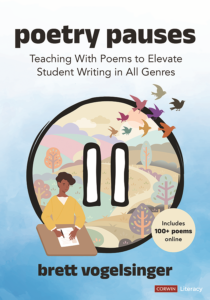Add the Power of Poetry to All Your ELA Lessons
Poetry Pauses: Teaching With Poems to Elevate Student Writing in All Genres
By Brett Vogelsinger
(Corwin Literacy, 2023 – Learn more)
Reviewed by Kasey Short

I have taught poetry in many ways over the years and this book provided me with lists of new ideas and poems that I want to incorporate in my class.

Vogelsinger begins by explaining how and why he uses poetry each day in his classroom to develop students’ reading, writing, and analytical skills. He is also realistic that teachers may not be able to implement it in the same way or with the same depth and provides ideas for using poetry that would not require a teacher to use it daily.
He is also honest about where his 9th graders are when they come to him and explains it would be different if they weren’t coming with prior knowledge. This acknowledgement and understanding allows readers to imagine from the beginning how his methods could be adapted to work for them.
Adding poetry pauses to your classroom
The book gives clear instructions and resources for beginning a system of “poetry pauses” where students spend varying amounts of time each day reading, analyzing, and/or writing poetry. It then gives detailed instructions on how poetry can be used to help students brainstorm, analyze literature, write in various genres, improve grammar and punctuation, and build a positive literacy routine.
If you are interested in using poetry to support a specific type of writing or skill, the book is designed so that you can read a chapter as a stand-alone section, gathering the information needed to use poetry to help teach that particular topic.
I found the chapter “Poetry Pauses for Improving Grammar and Punctuation Skills” provided me with excellent lesson ideas and showcased ways to use poetry that I haven’t seen before. I am always looking for a way to make teaching grammar more engaging and relevant, and this chapter provided information and resources for teaching multiple grammatical concepts in a refreshing format.
Tools for finding just the right poem
The book is filled with specific examples of poems to use in various situations as well as online resources to find more poems. Vogelsinger provides lists of wide-ranging poems to tackle almost any subject.
Some of my favorites include “Poems to Bring on the Brainstorm,” “Five Favorite Food Poems,” “Poems to Draw Our Attention to Nouns and Verbs,” and “Poems of Hope and Light.” Each of these lists are filled with diverse poets who have written poems that capture the reader’s imagination while helping to dig deeper into other areas of the English curriculum.
And the appendices of this book are not to be missed! “Appendix A: Strategies to Streamline and Scaffold” is a section that I wish was included in all education pedagogy books. It gives teachers specific ways to help make Vogelsinger’s ideas work for them. The strategies help save time, get to the heart of the matter, and make the activities accessable for different students.
I loved the idea of using poems written for children if the more complex poems are too cumbersome for students. I’ll also be trying his idea to create a fill-in-the-blank version of a poem, and the suggestion to use excerpts instead of entire poems in some situations.
Appendix B is filled with reproducible handouts that could be copied and used directly from the book. Finally, Appendix C is filled with inspiring and powerful quotes.
Guiding students to the power of poetry
Toward the end of the book Brett Vogelsinger writes, “Poems allow us to move within and eventually out of …corners. They let us start anywhere on the blank page, not just the top left corner. They let us manipulate the white space to get us where we need to go. They let us type a few quick lines in the notes section of our phones. They let in the sliver of light we need to keep going. Writing them gives us an escape hatch. Reaching them gives us companionship.”
Poetry is powerful, and this book provides teachers that guide they need to help their students find this power.
Read Brett Vogelsinger’s MiddleWeb article here
Kasey Short (@shortisweet3) is the Middle School Director of Studies and an 8th Grade English Teacher and Advisor at Charlotte (NC) Country Day School. Kasey loves to share ideas from her classroom and her leadership roles and writes frequently for MiddleWeb. She attended the University of North Carolina at Chapel Hill and earned a bachelor of arts in middle school education with a concentration in English and history. She went on to earn a master’s in curriculum and instruction from Winthrop University.


































